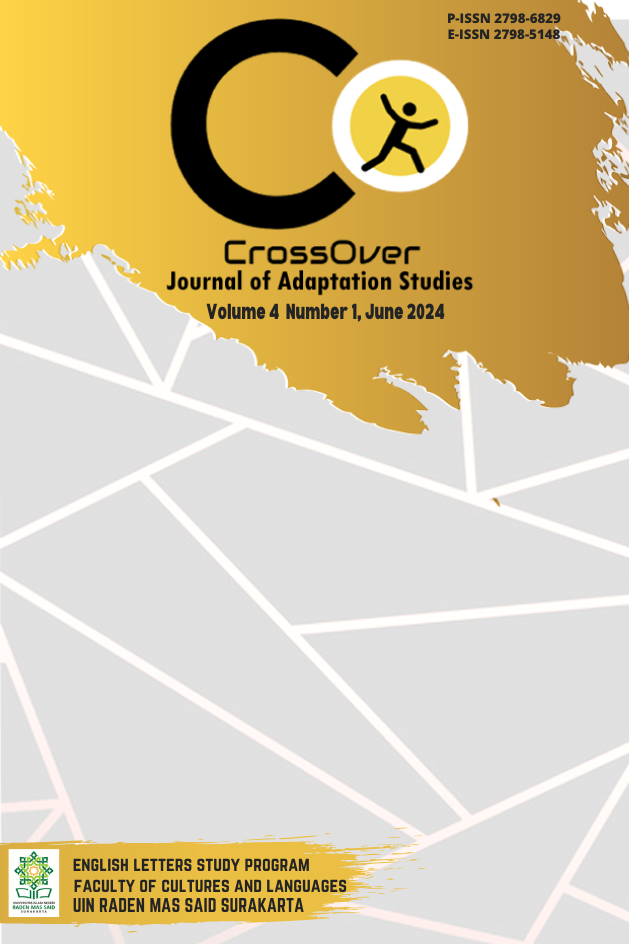A HUNDRED YEAR OF SITI NURBAYA: ADAPTATIONS FROM FILMS TO MUSICALS
DOI:
https://doi.org/10.22515/crossover.v4i1.8803Keywords:
alih wahana, ekranisasi, Siti Nurbaya, adaptasiAbstract
This objective of thi sresearch is to map the development of Siti Nurbaya story within its first hundred years. The data is taken from the adaptations of Siti Nurbaya novel into various forms resulting in intriguing discussions from the Nurbaya Musical Series and song lyrics about Siti Nurbaya. Changes from the novel to adaptation forms involve additions, reductions, and adjustments, which are then discussed. This study reveals: (1) the development of Nurbaya's character from the novel to adaptation forms, impacting the storyline and sociological aspects within these adaptations. (2) The addition of new characters, such as Etek Rahma, Nurbaya's conservative aunt, influences various events and plots within the adaptations. (3) Changes in perspective also create new viewpoints, for example, the followers of Datuk Meringgih who in the novel accept menial jobs for instant pleasure, whereas in adaptations, their motivation shifts to supporting their families. (4)Adjustments from the novel to adaptation forms are made to accommodate contemporary times and shorten the consumption time of literary works, thereby modifying conflicts to be more relevant to current contexts.
Downloads
References
Atikurrahman, M., Ilma, A. A., Dharma, L. A., et, al. (2021). Sejarah Pemberontakan dalam Tiga Bab: Modernitas, Belasting, dan Kolonialisme dalam Sitti Nurbaya. SULUK: Jurnal Bahasa, Sastra, Dan Budaya, 3(1), 1–22. https://doi.org/10.15642/suluk.2021.3.1.1-22
Damono, S. D. (2018). Alih wahana. Gramedia Pustaka Utama.
Eneste, P. (1991). Novel dan film. Nusa Indah.
Ernest, Y. K., & Nurgiyantoro, B. (2018). Kajian Ekranisasi: Dari Novel Pintu Terlarang Ke Film Pintu Terlarang. Diksi, 26(2), 120–127.
Giannetti, L. D., & Leach, J. (1990). Understanding movies (Vol. 1, Issue 1). Prentice Hall Englewood Cliffs, NJ.
Hutcheon, L. (2006). A theory of adaptation. Routledge.
Miles, M. B., & Huberman, A. M. (1994). Qualitative data analysis: An expanded sourcebook. Sage.
Mills, J. (2004). Clueless: Transforming Jane Austen’s Emma. Australian Screen Education Online, 34, 100–106.
Romadhon. (2017). Ekranisasi Sastra: Apresiasi Penikmat Sastra Alih Wahana. Buletin Al-Turas, 23(2), 267–286. https://doi.org/10.15408/bat.v23i2.5756
Rusli, M. (1920). Siti Nurbaya. Balai Pustaka.
Setiawati, R. R. (2017). Alih Wahana Novel Supernova Karya Dewi Lestari Menjadi Film Supernova Karya Rizal Mantovani Kajian Model Pamusuk Eneste. Dissertation. Universitas Negeri Makasar.
Woodrich, C. A. (2016). Implikasi Metodologis dari Teori Ekranisasi George Bluestone dalam Buku Novels Into Film. Jurnal Ilmiah Lingua Idea, 7(1), 248–253. https://jos.unsoed.ac.id/index.php/jli/article/view/332
Downloads
Published
How to Cite
Issue
Section
Citation Check
License
Copyright (c) 2024 Salma Dhiya Ulhaq, Risalah Damar Ratri

This work is licensed under a Creative Commons Attribution-ShareAlike 4.0 International License.
Authors retain copyright and grant the journal right of first publication with the work simultaneously licensed under a Creative Commons Attribution 4.0 International License that allows others to share the work with an acknowledgment of the work's authorship and initial publication in this journal.

















